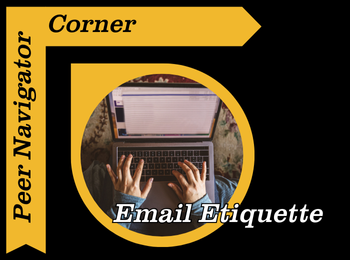Written by: Annalise Miller
At some point during your academic and professional journey, you will likely find yourself emailing a professor, university staff member, or other dignitary person. You might be writing to ask for a letter of recommendation, to apply for a job, or to communicate about an assignment. When that time comes, it is crucial to have solid email etiquette under your belt. Think of it as the art of writing polite, clear, and effective emails. The “rules” of email etiquette may vary depending on the recipient, but having a strong foundation in email etiquette will set you up for success in any situation.
As a college student, communication with professors through email is something that will undoubtedly happen during your years at Mizzou. Make sure that all MU-related emails are coming from your University assigned email address. Before constructing your email, write a clear and concise subject line. This helps clarify what your message is about and will help busy professors prioritize your email. “POL-SC 4641 Discussion Post Grade,” “Absence Notification for ENG 1000 on 2/02/2025,” or “Feedback Request for BUS 2000” are all examples of good subject lines. Subject lines should avoid all caps, emojis, or ambiguity.
Similar to writing a letter, emails should begin with a greeting. Try to avoid informal greetings like “What’s up, Kim,” or “Heyyyyy.” You are emailing a professional, not someone you just met online. “Ms. Kimberly Moeller” or “Dear Dr. Jones” are generally safe options, especially if you are unsure how the person prefers to be addressed. While some professors are fine with being called by their first names, others prefer to be referred to as “Dr.” or “Professor.”
Now, what about the body of your email? Make sure the recipient knows who you are and why you are contacting them in short, direct paragraphs. Do not make your email unnecessarily long or full of extraneous detail. That said, an important part of conciseness is making sure that you do not leave out any relevant information. Say everything that you need to say without being excessively wordy. In terms of follow-ups, try to wait at least 24 hours. This gives the recipient time to respond to your email.
Finally, use a professional sign off to conclude your email. For example: “Best, Annalise Miller” or “Sincerely, Shane Stearman”. You can get creative with this step, as long as you keep it polite and direct. Be sure to thank your recipient before signing off of your email, as well.
Before hitting “send,” do a quick proofread of your email. In emails, use grammar and punctuation as you would in any other piece of professional writing. Make sure that you do not overuse exclamation points (no matter how excited you are to be here at Mizzou) and end your sentences with periods. Do not type anything that you would not want to read out loud, either. Regardless of how mad you may be at a professor for not yet posting your grade, save the rage for ranting to your roommate. By following proper email etiquette, you can ensure effective communication while demonstrating professionalism and respect.
———————————————————————————————————————
Example Email:
Subject: POLSC 2000 Grade Inquiry
Dear Professor Smith,
I hope this message finds you well. My name is Annalise Miller, and I am a student in your POLSC 2000 class (Section 2, Fall 2025). I am reaching out to inquire about when the final grades for the course will be posted. I understand that grading can take some time, and I just wanted to check if there is an estimated date for when we might be able to view our grades.
Thank you for your time and for all your hard work throughout the semester. I appreciate any information you can provide.
Best regards,
Annalise Miller
